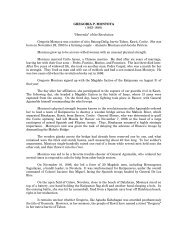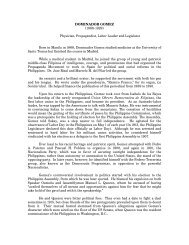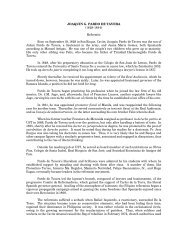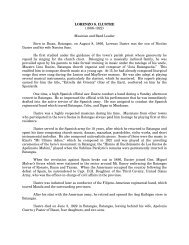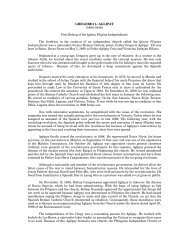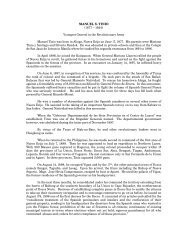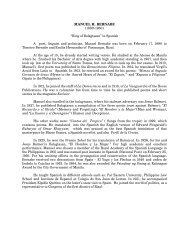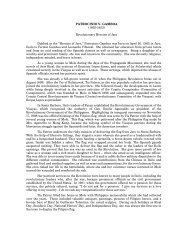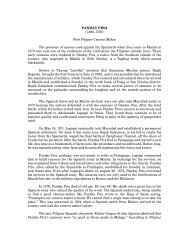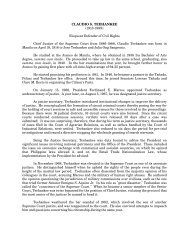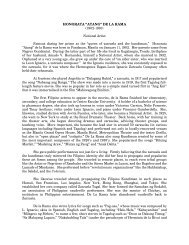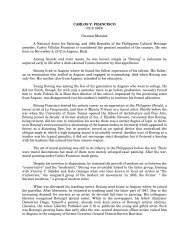ESTANISLAO LEGASPI - National Historical Commission of the ...
ESTANISLAO LEGASPI - National Historical Commission of the ...
ESTANISLAO LEGASPI - National Historical Commission of the ...
You also want an ePaper? Increase the reach of your titles
YUMPU automatically turns print PDFs into web optimized ePapers that Google loves.
<strong>ESTANISLAO</strong> <strong>LEGASPI</strong><br />
(Ca. 1892-1904)<br />
Orator, Mason and Revolutionary Figure<br />
The Tagalog Estanislao Legaspi was an artisan. He joined <strong>the</strong> Masonic movement in <strong>the</strong><br />
Philippines during its earliest beginnings. Later, toge<strong>the</strong>r with <strong>the</strong> bookkeeper and fellow Mason<br />
Agustin del la Rosa, he established <strong>the</strong> Masonic lodge called Integridad Española (No. 212) in<br />
Manila. He was cited by Wenceslao E. Retana, in Vida y Escritos de Dr. José Rizal, as having<br />
resided along Calle Madrid in Manila and Calle Encarnación in Tondo.<br />
In late June 1892, Rizal returned to <strong>the</strong> Philippines from abroad and, within a week, was<br />
said to have called a meeting <strong>of</strong> progressive Filipinos, mostly Masons, who were one in <strong>the</strong>ir desire<br />
to see meaningful social and political reforms instituted in <strong>the</strong>ir friar-dominated society. Held at<br />
<strong>the</strong> home <strong>of</strong> Domingo Ongjunco, a wealthy Chinese mestizo, <strong>the</strong> meeting was attended by Legaspi,<br />
along with pioneering Filipino Masons Pedro Serrano Laktaw, Jose Ramos, Timoteo Perez,<br />
Domingo Franco, Agustin de la Rosa, Ambrosio Salvador and his son Moises, Numeriano Adriano,<br />
Faustino Villaruel, Mariano Crisostomo, Apolinario Mabini, and Andres Bonifacio. In that<br />
meeting, Rizal voiced <strong>the</strong> pressing need to organize a league, which would seek <strong>the</strong> unity <strong>of</strong> <strong>the</strong><br />
whole archipelago and work for substantial reforms from <strong>the</strong> government. To be called La Liga<br />
Filipina, <strong>the</strong> league would endeavor to establish popular councils in key municipalities and<br />
provinces through its deputized leaders.<br />
Consequently, Legaspi was designated by Domingo Franco, who had been elected as<br />
president <strong>of</strong> La Liga Filipina, as president <strong>of</strong> <strong>the</strong> Binondo popular council, with Francisco Diwa as<br />
secretary and Tranquilino Torres as treasurer. Along with o<strong>the</strong>r Liga members Andres Bonifacio,<br />
Teodoro Plata and Francisco Diwa, he was tasked to organize popular councils in <strong>the</strong> suburbs <strong>of</strong><br />
Manila and in <strong>the</strong> provinces. He <strong>the</strong>n set up <strong>the</strong> popular council in Tondo called “Talang Bakero,”<br />
while Bonifacio, Francisco Nakpil, Juan Zulueta, and o<strong>the</strong>r active Liga members took care <strong>of</strong><br />
organizing those in Trozo, Sta. Cruz, etc. Among <strong>the</strong>ir recruits for <strong>the</strong> Binondo popular council was<br />
Antonio Salazar, whom Legaspi himself initiated at <strong>the</strong> house <strong>of</strong> Torres along Calle Elcano “one<br />
Sunday morning in February 1893”. Salazar was later executed in Bagumbayan, along with 12<br />
o<strong>the</strong>r Masons and revolutionaries.<br />
Left leaderless within a week <strong>of</strong> its establishment when Rizal was ordered exiled to Dapitan<br />
by <strong>the</strong> Spanish authorities, <strong>the</strong> reform-oriented Liga teetered between survival and dissolution.<br />
According to Domingo Franco, in his confession to <strong>the</strong> authorities following his arrest, <strong>the</strong> Liga<br />
members were divided into two factions, one <strong>of</strong> which gravitated towards <strong>the</strong> Katipunan, <strong>the</strong><br />
radical secret society founded by Bonifacio to seek Philippine independence through revolution,<br />
<strong>the</strong> o<strong>the</strong>r, towards <strong>the</strong> Cuerpo de Compromisarios, which shared <strong>the</strong> reformist goals <strong>of</strong> <strong>the</strong> Liga,<br />
whose members included Apolinario Mabini, Numeriano Adriano, Bonifacio Arivalo, and<br />
Ambrosio Flores. Legaspi chose to be part <strong>of</strong> <strong>the</strong> Compromisarios, under whose aegis he<br />
continued to head <strong>the</strong> erstwhile Binondo popular council <strong>of</strong> <strong>the</strong> Liga.<br />
During <strong>the</strong> crackdown ordered by Governor-General Blanco following <strong>the</strong> discovery <strong>of</strong> <strong>the</strong><br />
Katipunan in August 1896, Legaspi was among numerous Masons arraigned before <strong>the</strong> military<br />
courts. Later, according to historian Teodoro M. Kalaw, he served as a lieutenant colonel in <strong>the</strong><br />
infantry <strong>of</strong> <strong>the</strong> revolutionary army <strong>of</strong> General Emilio Aguinaldo. He is also believed to have taken<br />
over <strong>the</strong> command <strong>of</strong> Camarines during <strong>the</strong> latter part <strong>of</strong> <strong>the</strong> revolution.<br />
On December 23, 1900, he became a founding member, along with such former reformist<br />
leaders as T.H. Pardo de Tavera, Agustin de la Rosa, Ambrosio Flores and Tomas del Rosario, <strong>of</strong><br />
<strong>the</strong> Federal Party. Established at <strong>the</strong> peak <strong>of</strong> <strong>the</strong> war between <strong>the</strong> Filipinos and <strong>the</strong> American<br />
army, <strong>the</strong> Federal Party sought <strong>the</strong> immediate end <strong>of</strong> <strong>the</strong> conflict and restoration <strong>of</strong> peace for <strong>the</strong><br />
Filipinos to concentrate <strong>the</strong>ir energies on <strong>the</strong> country’s economic development. Their manifesto<br />
was issued on <strong>the</strong> same day <strong>of</strong> its founding. Along with Hipolito Magsalin and Mariano Abella, he<br />
was elected member <strong>of</strong> <strong>the</strong> party’s “Council <strong>of</strong> Administration”.<br />
A survivor <strong>of</strong> both <strong>the</strong> Philippine Revolution and <strong>the</strong> Filipino-American War, Legaspi<br />
continued to devote himself to <strong>the</strong> Masonic movement. He served as Orator <strong>of</strong> a Philippine Orient
mo<strong>the</strong>r lodge, called Primera Luz Oceánica, which existed in 1903-1904, <strong>the</strong> o<strong>the</strong>r <strong>of</strong>ficers being<br />
Vicente Lukban, senior warden; Jose Azas, junior warden; and Santiago Tindaya, secretary.<br />
References:<br />
Guerrero, Leon Ma. The First Filipino. Manila: <strong>National</strong> <strong>Historical</strong> Institute, 1987.<br />
Minutes <strong>of</strong> <strong>the</strong> Katipunan. Manila: <strong>National</strong> Heroes <strong>Commission</strong>, 1964<br />
Kalaw, Teodoro M. Philippine Masonry. An English Translation from <strong>the</strong> Spanish by<br />
Frederic H. Stevens and Antonio Amechazurra. Manila: Frederic H. Stevens, 1956.<br />
Schumacher, John N. Revolutionary Clergy: The Filipino Clergy and <strong>the</strong> <strong>National</strong>ist<br />
Movement,1859-1903. Quezon City: Ateneo de Manila University Press, 1981<br />
Taylor, John R.M. The Philippine Insurrection Against <strong>the</strong> United States Volumes 1 and 5.<br />
Pasay City: Eugenio Lopez foundation, 1970.



